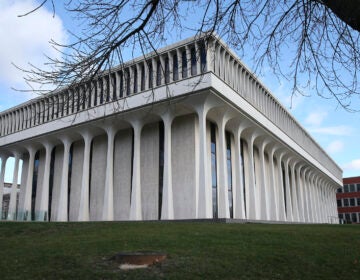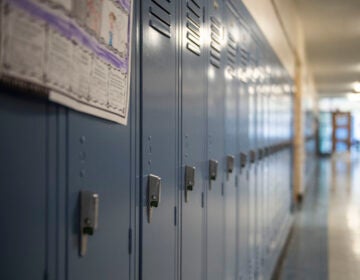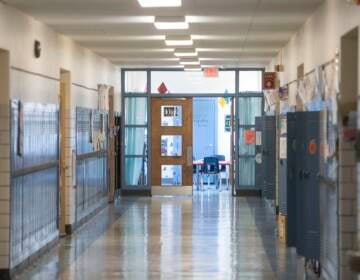Pa. charters deny ‘cherry-picking’ students, but data show special ed disparities
With new report, advocates seek fresh leverage in long-running battle over special ed payments to charters.

Kids in SPIN’s autism support preschool classroom do “center time” where they do independent activities related to their lessons. (Kimberly Paynter/WHYY)
This article originally appeared on The Notebook.
—
Pennsylvania’s charter schools are “gaming the system” to maximize special education payments, and then using the money to subsidize their regular operations, costing Pennsylvania taxpayers millions, according to a new study by the advocate group, Education Voters of PA.
“This report presents evidence of systemic cherry picking by charter schools of students with low-cost disabilities,” said Susan Spicka, executive director of Education Voters of PA. “It exposes fundamental flaws in the state’s funding formula that drive enrollment practices at charter schools and limit options for many students with disabilities.”
By forcing districts to pay charters a flat fee for all special ed students regardless of their needs, the report finds, Pennsylvania policy creates incentives for charters to over-enroll students needing low-cost services, and drive the harder-to-serve students back into district-run schools.
Fixing the enrollment imbalance could save Pennsylvania taxpayers as much as $100 million a year, the report found.
“This is like a doctor getting reimbursed for stitching up a small cut at the same rate that they’re paid for major surgery,” and then pocketing the profits, said Frank Gallagher, superintendent of the Souderton Area School District.
Charter operators and advocates don’t deny that charters subsidize day-to-day operations with special education payments, but the sector has long defended the practice, saying that charters need the cash.
“The basic ed rates in most districts are very low,” said Max Tribble, a spokesperson for Charter School Management, Inc., or CSMI, a for-profit company that manages the multi-campus Chester County Community Charter School. “The districts serving charter schools are among the lowest in funding for basic education.”
Tribble said that rather than tinkering with special education dollars, advocates such as Ed Voters PA should challenge the policies that have funded schools for generations. School funding shouldn’t be based on property taxes, he said.
“If [advocates] want to get something done that is meaningful, they should evaluate the entire system, probably beginning with the property tax-education funding system that creates such bias against disadvantaged communities,” said Tribble, whose company is owned by one of the state’s most influential Republican donors, businessman Vahan Gureghian.
Ed Voters PA released its study on Tuesday, hosting a conference call with Democratic lawmakers and advocates. Among those present was State Rep. Mike Sturla, a Democrat representing Lancaster’s 96th District whose long fight to reform special ed funding has met with little success.
Told of Tribble’s comments, Sturla said the charter sector often talks about broad-based reforms, but rarely if ever supports them.
“The people that are advocating for no change [to special education funding] are the same people who are advocating for less spending overall,” said Sturla. “I’m all for money for more education, everywhere. I’m also for not spending it in a wasteful way. I’ll vote for both those things. Those on the other side will vote for neither of those things.”
Long running debate
For the uninitiated – and even the experienced – debates over special education funding can be beyond baffling, featuring a seemingly bottomless tangle of tiers, formulas, requirements and calculations.
But at the heart of the debate is a simple question: are charter schools getting more special-ed funding than they deserve, at other students’ and taxpayers expense?
Spicka and other advocates have long argued that they do. Pennsylvania’s system creates incentives for charters to drive away the costliest special ed students, they say. This, in turn, forces school districts and local taxpayers to pick up the tab for expensive services, even as they overpay the charters for the low-cost special ed students the charters retain.
“Charter schools are not fully serving all students with disabilities,” said Souderton’s Gallagher. “Public schools must educate all levels of special education students, but the funding we receive hasn’t kept up with the cost … The local taxpayer must make up the difference,” he said.
Pennsylvania’s policy is “unfair and unjust,” Gallagher said.
Meanwhile, the charter sector has long countered that charters need and deserve all the special education dollars they receive, and that the purpose of the scrutiny is to destroy the charter sector, not protect students or budgets.
“Anti-charter groups are calling for spending cuts as a way to punish the families who leave their district school,” said the Pennsylvania Coalition of Public Charter Schools (PCPCS) in a statement, following the release of the Ed Voters report. Such advocates’ only goal is “to put charter schools out-of-business and eliminate competition for district schools,” PCPCS said.
Tribble took a similarly hard-line approach. While he had yet to scrutinize the Ed Voters study, he said that the reforms proposed for Pennsylvania special ed funding would effectively demolish the charter sector.
“It is fair to say that most charter schools in Pennsylvania would not survive under any of the proposals I have seen,” said Tribble.
These passionate defenses of the charters’ special ed funding help explain why change has proven nearly impossible. Assessing them can be difficult, sometimes by design; Tribble’s company, CSMI, for example, has consistently resisted requests to open its books.
Fair funding advocates like Ed Voters PA have been pushing reform for a decade or more, driven in no small part by the expansion of Chester Community Charter and its role in undermining the finances of its host school district. In 2013 a legislative commission took up the question, and a few modest changes have since been approved, but lawmakers have successfully exempted the charter sector from virtually all of them. Continued investigation of the issue by the press and advocates have revealed many concerns, but moved no changes.
Sturla said the reason why is simple: money talks, especially in Harrisburg. Charter advocates have spent “massive amounts” to protect the special ed status quo, he said. He hopes that the retirement of former Speaker of the House Mike Turzai, a powerful ally of the charter sector, could finally open the door to change.
“Now there’s no excuse,” Sturla said.
Charters have long denied any improper sorting: “the schools we support do not cherry pick,” said Tribble. Likewise, PCPCS’s statement noted that so far, no one has proven that charters do anything wrong.
“At a recent House Appropriations Committee hearing, Education Secretary Pedro Rivera was asked by lawmakers if his agency has any data to substantiate anti-charter groups’ claims that charter schools are acting improperly when it comes to identifying students in need of special education. Secretary Rivera said he did not,” PCPCS wrote.
However, the new Ed Voters PA report represents an attempt to capture data that proves what the sector denies: that charters tend to drive away the expensive-to-serve kids and keep the cheaper ones.
The new study breaks down enrollment data to show that charters tend to have significantly lower percentages of high-cost special education students – known as “Tier II” and “Tier III.” Such high-cost students require expert, often individual attention for such issues as autism, Downs syndrome, and severe learning disabilities.
Serving such high-cost students can cost tens of thousands of dollars per year. By comparison, low-cost, “Tier I” students need relatively inexpensive services that can be delivered in group settings, such as speech therapy.
“This gap between charter school funding and district per student averages implies either that students in charter schools are being given potential for superior educational opportunities compared to those remaining in district schools and/or, more likely, wasted surplus spending is padding the profits of charter school management organizations and the private entities with whom they have contracts,” the report states.
The Ed Voters study found that the overall pattern in Pennsylvania is that the costliest special-ed students – the Tier II & III group – end up in district-run schools.
There are exceptions, including a number of Philadelphia charters whose special education enrollments are comparable to those of the District overall. But overall, charters have larger percentages of the low-cost Tier I students than school districts, the study found.
“Enrollment patterns in special education tiers are consistent with the likelihood that many charter schools are exploiting the funding system by cherry picking students with low-cost special education needs and discriminating against students with high-cost needs,” the Ed Voters report concluded.
Old problem, new numbers
The new Ed Voters PA analysis shows that when compared to school districts’ enrollments, charters tend to enroll greater shares of the Tier I students who are least expensive and easiest to serve. The study relies on data from school districts and the Pennsylvania Department of Education for the 2017-18 school year.
Across the state, the data shows a clear pattern: while just about every school district has a significant chunk of high-need, Tier II and Tier III students, most charters have much smaller groups of such high-need students – and many have none at all.
Charters sign up “only half as many the students with high-cost special education needs as would be expected,” the study found, while still getting a “flat per-student tuition rate regardless of disability type.”
The findings, portrayed vividly in bar graphs included in the report’s appendix, shows how different charter and district enrollments tend to be.
Among all Pennsylvania charters, the report found, 41% enroll no high-cost special ed students at all. The same was true for 24 of 83 Philadelphia charters. Charters in ten Pennsylvania counties reported no high-cost special ed students at all, including Adams, Berks, Erie, Lancaster and Luzerne counties.
Cyber charters also steer clear of high-cost special ed students; seven cybers enroll no high-cost students at all, while the others enrolled 4 percent or less.
Among Philadelphia charters, the number of high-cost special education students is generally low, but with some major exceptions. The Discovery and Russell Byers charter schools’ special ed enrollment is 100% high-cost students. Many other charters enroll significant numbers of high-need special ed students, including Imhotep, Independence, KIPP West, Philadelphia Academy and the Universal Companies.
Likewise, the Mastery network tends to enroll relatively large numbers of high-cost students. At Mastery’s Lenfest, Clymer, Gratz and Mann campuses, the percentages of special education students ranked in Tiers II and III were 20, 19, 15 and 23 percent, respectively. All but Lenfest are converted District schools with defined catchment areas.
However, many other Philadelphia charters managed to enroll no high-cost special education students at all in 2017-18.
Among the charter schools whose special ed populations were entirely from the low-cost, Tier I category: Boys’ Latin, Esperanza, Franklin Towne (for both elementary and high school), Green Woods, Harrambee, ASPIRA at Stetson, Global Leadership, and Christopher Columbus.
By comparison, virtually all school districts have significant numbers of high-cost special ed students, the Ed Voters study says. In Philadelphia, about 18% of District special education students are high-cost. For Upper Darby, the figure is about 12%; for Lancaster, 8%; Lower Merion, about 10%; for Council Rock, about 16%.
According to the report, In the Chester-Upland school district, 15% of special ed students are in Tier II and III, compared to less than 2% at Chester Community and two other charters in the district. Chester Community is by far the biggest, with more than 4,300 students, more than 20% of which are designated special education.
Parents want change, but sector digs in
So while not every charter appears to “cherry pick,” and some appear to fully embrace the mission of serving high-cost students, the overall enrollment disparities cannot be an accident, Ed Voters PA and its supporters say.
Among the participants in Tuesday’s press conference were parent advocates Paulette Foster, of Pittsburgh, and Lisa Lightner, of Chester County. Foster said that parents of needy children in her city are routinely sent away from charters. She described one parent who enrolled her special needs child at charter only to be told almost immediately to leave.
“The second day she brought him there, they said, ‘We’re not accepting your child,” Foster said. “This child is traumatized … Parents of exceptional children do not want to feel like second-class citizens.”
Lighter said that charters’ disinterest in the toughest cases is an open secret. “There’s not a charter school in the state that would accept my child. If there was a ‘Tier IV’ he’d be in it,” she said. “If I got in, on the first day I’d be bullied out.”
Solving the problem will not be easy. Ed Voters’ analysis calls for several changes to funding, including the full implementation of the multi-tiered state funding formula from which charters are currently exempt.
“Applying the tiered Special Education Funding Formula (SEFF) to charter schools … combined with a cap on basic tuition rates for cyber charter schools, could save the state over $230 million annually,” the report concludes.
The report also calls for a cap on cyber charter tuition rates, and a new, more carefully “tiered” payment structure for charters.
Lightner said she doesn’t have a lot of patience for the argument that the status quo should remain just because charters need a way to make up for funding shortfall elsewhere.
“I’m sorry that charter schools are saying they don’t have enough money. They knew the rules when they opened their doors,” she said.
But charter advocates show no sign of wanting to compromise. School districts need to get their own financial houses in order before they come after charters, said Tribble, and the charter school law should be left strictly alone.
“That is the crisis in public education: the districts cannot figure out how to manage themselves, yet they spend a disproportionate amount of their time trying to tell the charter community how they should be operating,” he said. “We are not asking for anything more than what was in the original charter school law.”

Get daily updates from WHYY News!
WHYY is your source for fact-based, in-depth journalism and information. As a nonprofit organization, we rely on financial support from readers like you. Please give today.






